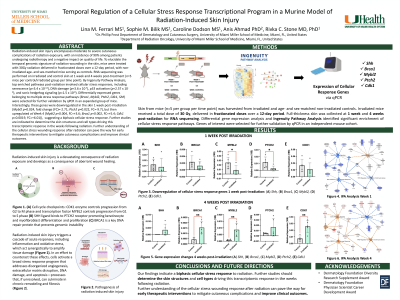Laboratory Research
(LR-016) Temporal Regulation of a Cellular Stress Response Transcriptional Program in a Murine Model of Radiation-induced Skin Injury
Friday, May 2, 2025
7:45 PM - 8:45 PM East Coast USA Time

Sophie Bilik, Medical Student; Caroline Dodson, PhD Candidate; Anis Ahmad, PhD; Rivka Stone, MD, PhD
Introduction: Radiation-induced skin injury encompasses moderate to severe cutaneous complications of radiation exposure, with an incidence of 90% among patients undergoing radiotherapy and a negative impact on quality of life.
Methods: To elucidate the temporal genomic signature of radiation wounding in the skin, mice were treated with 30Gy radiation delivered in fractionated doses over a 12-day period, with non-irradiated age- and sex-matched mice serving as controls. RNA sequencing was performed on irradiated and control skin at 1 week and 4 weeks post-treatment (n=5 mice per control/irradiated group per time point).
Results: By Ingenuity Pathway Analysis, top enriched pathways post-radiation involved cellular stress responses, including senescence (p=3.4e-12), DNA damage (p=3.6e-7), p53 activation (p=2.57e-4), and sonic hedgehog signaling (p=1.5e-6). Differentially expressed genes belonging to multiple stress response pathways (Brca1, Mybl2, Ptch2, Cdk1, Shh) were selected for further validation by qPCR in an expanded group of mice. Interestingly, these genes were downregulated in the skin 1 week post-irradiation (Mybl2 p</em>=0.024, fold change (FC)=-2.71; Ptch2 p=0.022, FC=-9.7), but then upregulated at Week 4 (Mybl2 p=0.004, FC=+3.6; Brca1 p=0.002, FC=+5.4; Cdk1 p=0.0019, FC=+6.01)), suggesting a biphasic cellular stress response.
Discussion: Further studies are indicated to determine the skin structures and cell types driving this transcriptomic response in the weeks following radiation. Further understanding of the cellular stress wounding response after radiation can pave the way for early therapeutic interventions to mitigate cutaneous complications and improve clinical outcomes.
Methods: To elucidate the temporal genomic signature of radiation wounding in the skin, mice were treated with 30Gy radiation delivered in fractionated doses over a 12-day period, with non-irradiated age- and sex-matched mice serving as controls. RNA sequencing was performed on irradiated and control skin at 1 week and 4 weeks post-treatment (n=5 mice per control/irradiated group per time point).
Results: By Ingenuity Pathway Analysis, top enriched pathways post-radiation involved cellular stress responses, including senescence (p=3.4e-12), DNA damage (p=3.6e-7), p53 activation (p=2.57e-4), and sonic hedgehog signaling (p=1.5e-6). Differentially expressed genes belonging to multiple stress response pathways (Brca1, Mybl2, Ptch2, Cdk1, Shh) were selected for further validation by qPCR in an expanded group of mice. Interestingly, these genes were downregulated in the skin 1 week post-irradiation (Mybl2 p</em>=0.024, fold change (FC)=-2.71; Ptch2 p=0.022, FC=-9.7), but then upregulated at Week 4 (Mybl2 p=0.004, FC=+3.6; Brca1 p=0.002, FC=+5.4; Cdk1 p=0.0019, FC=+6.01)), suggesting a biphasic cellular stress response.
Discussion: Further studies are indicated to determine the skin structures and cell types driving this transcriptomic response in the weeks following radiation. Further understanding of the cellular stress wounding response after radiation can pave the way for early therapeutic interventions to mitigate cutaneous complications and improve clinical outcomes.

.jpg)